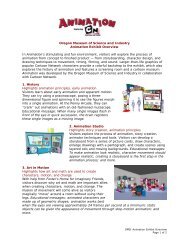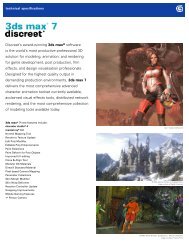New in Maya 5 - 3DV
New in Maya 5 - 3DV
New in Maya 5 - 3DV
You also want an ePaper? Increase the reach of your titles
YUMPU automatically turns print PDFs into web optimized ePapers that Google loves.
functionality of <strong>Maya</strong> will be available via an embedded l<strong>in</strong>k to the Alias|Wavefront website. Similar packages have been made available <strong>in</strong> the past<br />
as Bonus Games Tools.<br />
“Extras” are located on the Documentation, Lessons and Extras CD and <strong>in</strong>clude sample scenes and data files which can be a start<strong>in</strong>g po<strong>in</strong>t for<br />
develop<strong>in</strong>g your own orig<strong>in</strong>al content, or simply be used to learn <strong>Maya</strong>.<br />
General Enhancements<br />
Another new <strong>Maya</strong> 5 timesav<strong>in</strong>g tool is the dgtimer MEL Command that measures computation time per dependency graph node, enabl<strong>in</strong>g you to<br />
identify, and then quickly elim<strong>in</strong>ate bottlenecks. Universal menu items and <strong>in</strong>dustry-standard hotkeys for cut, copy and paste have also been added<br />
which will work with all model<strong>in</strong>g view selections, plus animation clips, keyframes and more. Improvements to multi-level referenc<strong>in</strong>g and hotswapp<strong>in</strong>g<br />
will prove highly useful to those facilities with asset management frameworks that control scenes and their references.<br />
Additionally, this latest version of <strong>Maya</strong> software conta<strong>in</strong>s a Move Along Rotation Axes tool, a universal hot-key for “dolly<strong>in</strong>g” <strong>in</strong> and out, a “locked<br />
nodes” display feature, and a choice of “copied” or “default” preferences when <strong>in</strong>stall<strong>in</strong>g a new version of the software.<br />
Unique Image Creation Possibilities<br />
<strong>Maya</strong> 5 software offers you more image creation possibilities than ever before. As a leader <strong>in</strong> computer graphics technology, Alias|Wavefront has<br />
long been committed to devis<strong>in</strong>g new and more efficient ways to realize myriad styles of imagery required by the professional marketplace. In <strong>Maya</strong><br />
4.5, fluid dynamics technology was <strong>in</strong>troduced to help animators reproduce numerous 2D and 3D atmospheric effects and other natural phenomena.<br />
Now, with <strong>Maya</strong> 5, we <strong>in</strong>troduce new render<strong>in</strong>g options and a simplified render<strong>in</strong>g workflow to give you the ability to create the right f<strong>in</strong>ished look<br />
for any type of professional graphics project. You can now select between the native <strong>Maya</strong> software renderer, a new Hardware Renderer, a new<br />
Vector Renderer, and the <strong>in</strong>tegrated mental ray for <strong>Maya</strong> renderer.<br />
Hardware Render<strong>in</strong>g<br />
The new <strong>Maya</strong> 5 Hardware Renderer enables you to quickly generate images for pre-visualization and broadcast-quality f<strong>in</strong>al output. Tak<strong>in</strong>g<br />
advantage of the ever-<strong>in</strong>creas<strong>in</strong>g power of next-generation graphics cards, this new render<strong>in</strong>g option uses vertex and pixel programmability to<br />
generate near software-quality images significantly faster.<br />
High-quality hardware render<strong>in</strong>g can be up to 20 times faster than software render<strong>in</strong>g − depend<strong>in</strong>g on image resolution and the hardware used. Also,<br />
the range of render<strong>in</strong>g effects possible has <strong>in</strong>creased significantly. For example, hardware particles and the rest of a scene can be rendered with<br />
specular highlights, reflections, bumps or shadows − all at the same time. This is a more efficient approach than render<strong>in</strong>g particles separately and<br />
then composit<strong>in</strong>g them <strong>in</strong>to the scene later.<br />
Hardware render<strong>in</strong>g on the W<strong>in</strong>dows and L<strong>in</strong>ux operat<strong>in</strong>g systems supports: ATI® Fire GL X1, ATI Fire GL Y1, NVidia Quadro® 2 and NVidia<br />
Quadro 4 graphics cards. On Mac OS X the GeForce®4 Ti is supported.<br />
Full support for hardware off-screen, background, batch render<strong>in</strong>g is available from both the <strong>Maya</strong> UI and the command l<strong>in</strong>e.<br />
7





